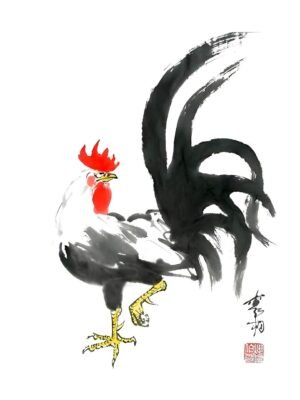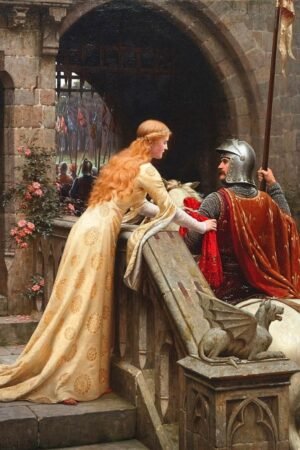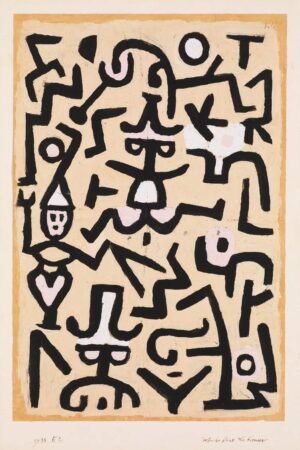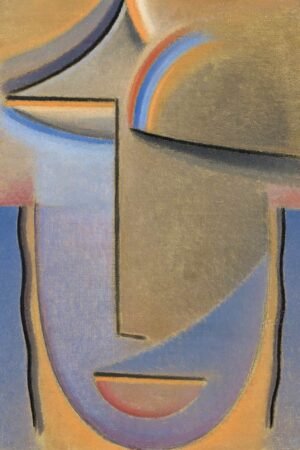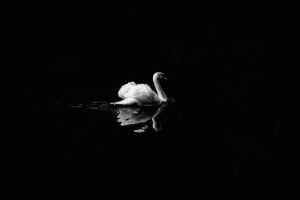The Kiss (or in German, Der Kuss) is one of the most reproduced and recognizable artworks of all time by Symbolist painter Gustav Klimt. Painted around 1908, it remains one of the most famous works in Klimt’s expansive oeuvre.
In this article, we’re going to take a closer look at The Kiss by Klimt, learn a bit about the fascinating artist behind the work, and explore some interesting facts about the work.
What’s Happening In The Kiss by Klimt?
As the name suggests, The Kiss depicts a tender moment as a man and a woman embrace each other among a patch of flowers. Although they appear to be standing at first glance, they are actually kneeling. Strings of golden shapes flow down the woman’s bare ankle onto the patch of wildflowers. The man cradles the woman’s face lovingly yet passionately, his face bent down to kiss her. The woman has an expression of peace, her eyes closed in the tender moment. Blush fills her cheeks, adding to the sensuality of the scene.
One of the most iconic aspects of the painting is the clothing. They are both dressed in elaborate, beautiful, and golden robes decorated in an Art Nouveau style—the man’s robes is speckled with black and white rectangles, and the woman’s with bright sinuous shapes.
The background is gold and flat, naturally bringing the viewer’s eye to rest on the couple. The bottom of the painting is dominated by flowers, also treated in an abstract way. Interestingly, the patch of flowers ends dramatically, making the figures seem as if they are on the edge of a golden abyss, only interrupted by the artist’s signature.
Gustav Klimt is known for his dramatic Symbolist works centered around themes of love, sexuality, and intimacy, which he typically explored with the lone female figure. The Kiss is no different, although it does bring in feelings of sweet tenderness, perhaps more than some of his other more erotic paintings.
Buy The Kiss by Klimt on The Soul of Art!
What do you think of this dazzling work? If you like The Kiss by Klimt as much as we do, you can purchase a print on FramedCanvasArt. Check it out here: The Kiss Print by Gustav Klimt
About Gustav Klimt
Before we focus specifically on The Kiss, let’s do a brief overview of Gustav Klimt.
Although he received a mostly classical art education, he quickly departed from a realistic style, moving instead toward Symbolism. This style is quite broad and spans literary and visual art, but often employs metaphorical images and mythological references to represent absolute truths.
Klimt was a founding member of the Vienna Secession, a movement in the Austrian capital that broke with some of the mainstream conventions of the time. In a time when more radical artists—such as Klimt—were being denied opportunities because of their style, the Vienna Secession aimed to give exhibitions to unconventional young artists. Oddly, before they founded the Secession, the talent of radical artists was recognized, yet they still missed out on opportunities in favor of more conservative artists.
Another interesting note is that these forward-thinking artists did not drive the Secession towards any one style. They accepted Naturalists, Symbolists, and Realists alike and focused their energy on giving all kinds of artists chances to exhibit their work.
On a more personal note, Klimt was quite private and famously never did a self-portrait. He reportedly said, “There is nothing that special to see when looking at me.”
To learn more about the life of Gustav Klimt, check out The Soul of Art’s post on him and more of his most famous works.
So, what exactly makes The Kiss so remarkable? We see it everywhere—on mugs, blankets, posters, and more—but let’s take a moment to really linger on the deeper aspects and context of the painting to appreciate it to the fullest.
1. Society of the early 1900s thought it was scandalous.
If you are a student of art history, you might’ve noticed a pattern: some of the most famous artworks that we still admire today caused some sort of outrage when they were first exhibited. Claude Monet, Marcel Duchamp, Judy Chicago….the list of artists who outraged the public goes on and on. Gustav Klimt is no exception.
How did this relatively modest artwork (by today’s standards) cause an outcry? Even though the figures are completely clothed, many people perceived the painting as completely scandalous. This reading was partially due to Klimt’s established reputation as a painter focusing on sexuality and desire, at times in a profane way. He famously said, “all art is erotic.”
There’s no denying that Klimt had an interest in exploring sexuality—however, interestingly, The Kiss was on the tamer end of his work. So, although it was more modest, it still indulged in themes that were too much for some to handle.
Additionally, some even viewed The Kiss as sacreligious, since he uses excessive amounts of gold leaf, a materially often reserved for religious subjects in the past.
2. The artist created The Kiss in the aftermath of dismal failure.
Let’s build off the first fact by putting The Kiss into the context of Klimt’s career. Even though The Kiss was scandalous to some, it caused much less outrageous than his previous work. There is even some speculation that Klimt reacted to this failure by creating a more modest work.
What was it that caused so much scandal in the years before he created The Kiss? In 1894, he received a commission to paint three paintings on the ceiling of the University of Vienna’s great hall—he didn’t complete them until after the turn of the century.
Once completed, the paintings were criticized as being dark due to its radical themes and pornographic due to the nude figures Klimt included. Traditional ideas were transformed into more sexual themes, which offended the public. For example, he used female nudes as a metaphor for philosophy, jurisprudence, and medicine.
The paintings were heavily derided and tarnished Klimt’s image from every corner—religious, aesthetic, and political. They were not displayed on the ceiling and Klimt had to take them elsewhere. The three paintings were eventually destroyed by retreating German forces in 1945.
After this failed commission, he vowed to never accept another one again. Shortly after, he painted The Kiss. While The Kiss was also marred with some con
3. The Kiss by Klimt was made at the height of artist’s “Gold Period.”
The Kiss by Klimt belonged to a period where he achieved positive recognition and financial achievements: his “Golden Period.” In fact, some historians consider The Kiss to be the height of this phase.
This era is aptly named. From roughly 1901 to 1909, Klimt used a significant amount of gold leaf in his works, resulting in glittering compositions. The extensive use of gold was partially inspired by Byzantine art, which we’ll explore more below. However, it is worth noting that his father was a gold engraver, so the material had a personal element as well.
The Kiss, in particular, actually includes gold leaf, silver, and platinum, resulting in a beautiful sparkling surface, made even more dramatic by its enormous 6 x 6-foot dimensions.
The gold leaf in this (and his other Gold Period pieces) is a big part of what makes The Kiss so recognizable. We can’t help but imagine how spectacular the massive dazzling composition is in person at its home at the Österreichische Galerie Belvedere in Austria.
4. The people who inspired the figures in The Kiss are unknown.
Part of what makes Klimt’s work interesting and mysterious is that he didn’t really talk about the inspiration behind his work. He rarely provided an explanation of his work. The Kiss is no exception, so naturally there’s a bit of speculation on who the figures are.
There are different views on who the figures in the painting are. Some think that the woman is based on Emilie Flöge, his lifelong companion, but others suggest that she is “Red Hilda,” a model of the time. Either way, she bears a strong resemblance to figures in other Klimt paintings, such as Goldfish and Danaë.
The woman’s face is one of the most realistic parts of the painting. So, although we don’t know who she is, she does feel like a real and specific person. Additionally, the woman’s face shows Klimt’s formal artistic talent regarding realism.
On another note, some historians suggest that The Kiss may be Klimt’s visual manifestation of a Greek myth, Orpheus and Eurydice, which was a popular story among painters around Klimt’s time.
5. It was sold before Klimt finished it.
Even though some saw it as pornographic (especially in the wake of previous artworks that jaded Klimt’s image), The Kiss was actually sold before Klimt had finished it. The Belvedere Museum of Vienna, Austria, was the purchaser, and it still resides there today.
They paid 25,000 crowns for it—which translates to roughly $240,000. While this isn’t a mind-blowing price ticket for today’s art market, it was a big deal back then. Before that sale, the record number of crowns for a painting was 500.
The Kiss by Klimt remains an Austrian treasure today, and it’s very unlikely it will ever be sold. However, for context, Klimt’s portrait painting Adele Bloch-Bauer sold at auction for $135 million in 2006, which broke the record for the highest price ever paid for a painting. Just imagine what The Kiss would sell for!
6. It embodies many different artistic styles.
Part of what makes Klimt’s work so visually unique is the melding of many influences, namely Byzantine and Japanese art.
Let’s start with the Byzantine-esque qualities. Have you ever seen the stunning gold mosaics of the Byzantine era? One quick look, and you’ll be able to tell that he was inspired by these in The Kiss. Definitely check out Byzantine art if you haven’t before.
So, how does this influence present itself in The Kiss? In Byzantine art, the figures are not typically painted in a realistic way—for example, faces in Byzantine mosaics have a flat feeling to them. However, the biggest Byzantine influence can be seen in his extensive use of gold leaf. This influence came about after Klimt took trips to Venice and Ravenna, where he came across the glittering Byzantine art in places such as the Basilica of San Vitale.
Additionally, like many French Impressionists, Klimt was heavily influenced by Japanese art, specifically woodblock prints known as Ukiyo-e (think of the iconic Great Wave by Hokusai). In fact, Klimt was an enthusiastic collector of Japanese art.
In The Kiss, this can be seen in the flattening of perspective and the overall simplified composition. For example, the figures just barely stay in the borders—this unconventional cropping is common in woodblock prints. There’s also a tension between flatness and 3-D feelings common in Japanese prints.
Lastly, this isn’t an influence per se, but it does have an air of fin-de-siecle spirit. There’s a sense of decadence and complicated emotion associated with some art at the turn of the 20th century.
7. It is a beautiful display of Klimt’s Art Nouveau style.
Briefly, Art Nouveau was a style of architecture and design that employed flowing curved lines and shapes. These elements were transferred into fine art through Symbolist painters like Klimt.
The shapes decorating the robes are the best examples of this. The woman’s robe is full of organic and whimsical circles, while the man has starker geometrical features on his outfit. These bold choices, combined with the fine, delicate lines Klimt uses to form the hands and facial features, form a very interesting balance and visual interest. He also creates masculine and feminine energy and emphasizes the union of spirituality and sensuality.
Klimt freely used design elements in all of his work. You can see these patterns throughout Klimt’s paintings, especially soft swirls, imbuing Art Nouveau into the body of work. Overall, it’s an interesting example of Art Nouveau in fine art.
8. The Kiss by Klimt departs from his other work in some ways.
The Kiss, although often might be the first work you think of regarding Klimt, actually departs from much of his work. This is largely due to his inclusion of a male figure in the painting. Although he often explored love and sexuality, Klimt typically did so through the lone female form. Even though his face is hidden, just the mere inclusion of his figure is out of the norm for Klimt.
Additionally, we mentioned earlier how it’s comparatively tamer than other works, especially in that the figures are clothed. The only skin visible is the women’s foot.
9. There have been many references to The Kiss by Klimt in pop culture.
You’ve probably seen The Kiss on art websites, but did you know it has made quite a few appearances in pop culture? Something about the painting has caught on with different media. Although it’s not necessarily the most serious element of The Kiss, it’s fun to explore some of the places it appeared in the roughly 115 years since its creation.
One example is in the famous American show Buffy the Vampire Slayer. In one scene, there are several posters of The Kiss, showing how common it was as a dorm room poster. It also shows up in The Adventures of Young Indiana Jones, the movie This Means War, and the anime series Elfen Lied.
Here’s another fun one. Klimt’s glittering, dramatic robes, both seen in The Kiss and other works, were the inspiration for the Christian Dior Spring 2008 Haute Couture collection. Check it out—it’s really interesting to see these sparkling geometrics in person. The reference is pretty obvious once you’ve seen Klimt’s work, and it’s neat to have Klimt’s abstract language come alive as a real outfit.
Lastly, Google commemorated The Kiss by Klimt with a “Google Doodle” (a temporary modification to Google’s homepage logo) in 2012, coinciding with Klimt’s 150th birthday.
10. The Kiss has been featured on a coin.
Pop culture isn’t the only place The Kiss by Klimt shows up! In 2003, roughly 100 years after Klimt’s famed Golden Period, the Austrian mint issued a commemorative 100 Euro gold coin featuring The Kiss. This also coincides with Klimt’s 150th birthday.
There is a small etching of The Kiss on one side, and on the other side, there is a bust of Klimt. It is a lovely way to celebrate this famous Austrian painter and one of his most iconic works.
Discover Our Latest Art Prints
Explore the latest additions to our curated art collection, designed to inspire every room.
-

Chinese Rooster Art Print
Price range: $23.00 through $139.00 This product has multiple variants. The options may be chosen on the product page -

God Speed Art Print by Edmund Blair Leighton
Price range: $23.00 through $209.00 This product has multiple variants. The options may be chosen on the product page -

Paul Klee Comedians Handbill Abstract Art Print
Price range: $23.00 through $209.00 This product has multiple variants. The options may be chosen on the product page -

Abstract Head of woman, Evening Print Alexej von Jawlensky
Price range: $23.00 through $209.00 This product has multiple variants. The options may be chosen on the product page -

White Swan Floating on Dark Water Wall Art Print
Price range: $23.00 through $209.00 This product has multiple variants. The options may be chosen on the product page -

Black and White Sunflower Field Wall Art Print
Price range: $23.00 through $209.00 This product has multiple variants. The options may be chosen on the product page


